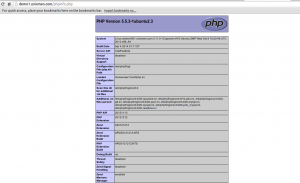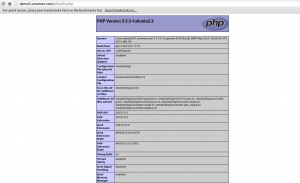Introduction
In this tutorial, we will install the apache2 with FastCGI. Using Fastcgi with PHP, we can set up multiple PHP version, and use suexec to support web user with their own instance of PHP, which mean we can separate php.ini file for each web users.
Install Apache2
apt-get install apache2 apache2-mpm-worker libapache2-mod-fcgid apache2-suexec-custom
Install PHP5
apt-get install php5 libapache2-mod-php5 php5-cgi php5-cli php5-gd php5-mysql php5-json
Install mysql-client
apt-get install mysql-client
Edit suexec userdir,
vi /etc/apache2/suexec/www-data
with content:
/home/ public_html/cgi-bin
Setting up fcgi in home users.
Create a user name “user1”
useradd -m user1 cd /home/user1
Create folder cgi-bin with a sub directory in home user1.
mkdir -p cgi-bin/php5-default
cd cgi-bin/php5-default
Create a file name php-fcgi-wrapper,
vi php-fcgi-wrapper
with content:
#!/bin/sh # Wrapper for PHP-fcgi # This wrapper can be used to define settings before launching the PHP-fcgi binary. # Define the path to php.ini. This defaults to /etc/phpX/cgi. export PHPRC=/home/user1/conf # Define the number of PHP child processes that will be launched. # This is low to control memory usage on a server that might launch # these processes for lots of domains. # Leave undefined to let PHP decide. export PHP_FCGI_CHILDREN=0 # Maximum requests before a process is stopped and a new one is launched export PHP_FCGI_MAX_REQUESTS=0 # Launch the PHP CGI binary # This can be any other version of PHP which is compiled with FCGI support. exec /usr/bin/php5-cgi
and save and make file executable:
chmod +x php-fcgi-wrapper
create an other folder name conf in this home user1.
mkdir /home/user1/conf cd /home/user1/conf
Create file php.ini,
vi php.ini
with content:
display_errors = On
Go to home user1 and create folder name public_html.
cd /home/user1 mkdir public_html
Create a phpinfo file in public_html,
cd public_html vi phpinfo.php
with content:
<?php phpinfo(); ?>
Change ownership to user1.
chown -R user1:user1 /home/user1/
Setting up Virtualhost:
vi /etc/apache2/sites-available/demo1.unixmen.com.conf
with content:
<VirtualHost *:80> DocumentRoot /home/user1/public_html ServerName demo1.unixmen.com SuexecUserGroup user1 user1 ErrorLog /var/log/apache2/demo1-error_log LogLevel debug CustomLog /var/log/apache2/demo1-access_log combined <Directory /> Options FollowSymLinks AllowOverride All Require all granted </Directory> AddHandler php-fcgi .php Action php-fcgi /fcgi-bin/php-fcgi-wrapper # FastCgiExternalServer /var/www/cgi-bin/php5-default_php538 -socket /var/run/php5-fpm.sock -pass-header Authorization # Define alias "/fcgi-bin/". The action above is using this value, which means that # you could run another "php5-cgi" command by just changing this alias Alias /fcgi-bin/ /home/user1/cgi-bin/php5-default/ # Turn on the fcgid-script handler for all files within the alias "/fcgi-bin/" <Location /fcgi-bin/> SetHandler fcgid-script Options +ExecCGI </Location> RewriteEngine On RewriteRule ^/fcgi-bin/[^/]*$ / [PT] </VirtualHost>
Enable site:
a2ensite demo1.unixmen.com.conf
Disable module php5:
a2dismod php5
Enable modules:
a2enmod suexec actions rewrite
Restart service apache2.
service apache2 restart
Check the PHP info for user1.
http://demo1.unixmen.com/phpinfo.php
Setting up fcgi for user2:
Create a user name “user2”
useradd -m user2 cd /home/user2
Create folder cgi-bin with a sub directory in home user2.
mkdir -p cgi-bin/php5-default cd cgi-bin/php5-default vi php-fcgi-wrapper
with content:
#!/bin/sh # Wrapper for PHP-fcgi # This wrapper can be used to define settings before launching the PHP-fcgi binary. # Define the path to php.ini. This defaults to /etc/phpX/cgi. export PHPRC=/home/user2/conf # Define the number of PHP child processes that will be launched. # This is low to control memory usage on a server that might launch # these processes for lots of domains. # Leave undefined to let PHP decide. export PHP_FCGI_CHILDREN=0 # Maximum requests before a process is stopped and a new one is launched export PHP_FCGI_MAX_REQUESTS=0 # Launch the PHP CGI binary # This can be any other version of PHP which is compiled with FCGI support. exec /usr/bin/php5-cgi
and save and make file executable:
chmod +x php-fcgi-wrapper
create an other folder name conf in this home user1.
mkdir /home/user2/conf cd /home/user2/conf vi php.ini
with content:
display_errors = On
Go to home user2 and create folder name public_html.
cd /home/user2 mkdir public_html
Create a phpinfo file in public_html.
cd public_html vi phpinfo.php
with content:
<?php phpinfo(); ?>
Change ownership to user.
chown -R user2:user2 /home/user2/
Setting up Virtualhost:
vi /etc/apache2/sites-available/demo2.unixmen.com.conf
with content:
<VirtualHost *:80> DocumentRoot /home/user2/public_html ServerName demo2.unixmen.com SuexecUserGroup user2 user2 ErrorLog /var/log/apache2/demo2-error_log LogLevel debug CustomLog /var/log/apache2/demo2-access_log combined <Directory /> Options FollowSymLinks AllowOverride All Require all granted </Directory> AddHandler php-fcgi .php Action php-fcgi /fcgi-bin/php-fcgi-wrapper # FastCgiExternalServer /var/www/cgi-bin/php5-default_php538 -socket /var/run/php5-fpm.sock -pass-header Authorization # Define alias "/fcgi-bin/". The action above is using this value, which means that # you could run another "php5-cgi" command by just changing this alias Alias /fcgi-bin/ /home/user2/cgi-bin/php5-default/ # Turn on the fcgid-script handler for all files within the alias "/fcgi-bin/" <Location /fcgi-bin/> SetHandler fcgid-script Options +ExecCGI </Location> RewriteEngine On RewriteRule ^/fcgi-bin/[^/]*$ / [PT] </VirtualHost>
Enable site:
a2ensite demo2.unixmen.com.conf
Restart service apache2
service apache2 restart
Check the PHP info for user2
:http://demo2.unixmen.com/phpinfo.php
Note, Check in these phpinfo for user1 and user2 use different php.ini. We can add specific options for php.ini for each user with different settings. If we do not add for these user php.ini, I will take from the default php.ini.
That’s all, Enjoy 😉







